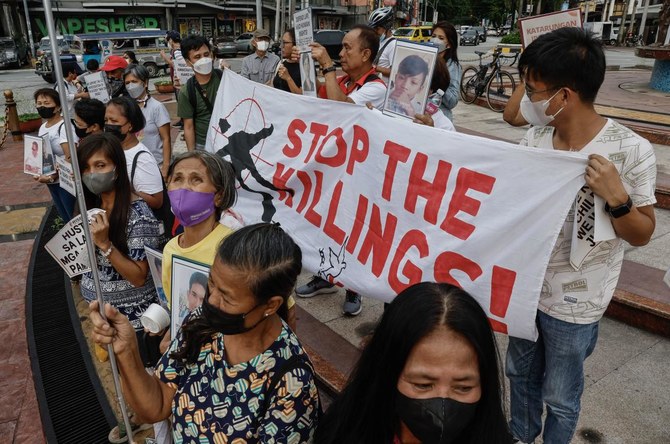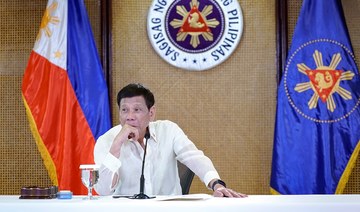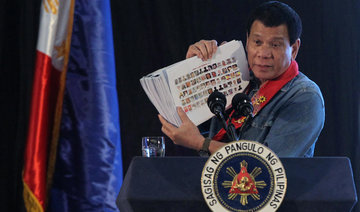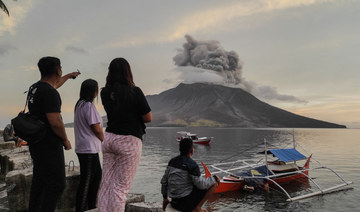MANILA: Philippines President Ferdinand Marcos Jr said on Friday his government will not cooperate with the International Criminal Court’s (ICC) investigation into the thousands of killings committed during his predecessor’s ‘war on drugs’.
Marcos maintained the ICC has no jurisdiction over the Southeast Asian country, which withdrew from the ICC in March 2019.
“We will not cooperate with them in any way, shape or form,” Marcos told reporters, just days after appeals judges at the ICC rejected the Philippines’ attempt to block an investigation by the court’s prosecutors into the anti-narcotics campaign of former president Rodrigo Duterte.
Thousands of people were killed during anti-drug operations that ended in shootouts during Duterte’s six-year term, rights groups say. Police have officially acknowledged roughly 6,200 deaths and reject accusations of systematic executions and cover-ups.
Marcos said the alleged crimes must be dealt with in the country as they were committed in Philippine territory. The justice ministry has promised its own investigation into the drugs war will be fair.
“We continue to defend the sovereignty of the Philippines and continue to question the jurisdiction of the ICC in their investigations here in the Philippines,” Marcos said.
While the Philippines is no longer a signatory to the international tribunal, the ICC’s top prosecutor has said the court does have jurisdiction because the country was a party at the time the alleged crimes were committed.
Philippines will not cooperate with ICC in drugs war probe – Marcos
https://arab.news/vd2sf
Philippines will not cooperate with ICC in drugs war probe – Marcos

- Philippines President Ferdinand Marcos Jr. maintains the International Criminal Court has no jurisdiction over the Southeast Asian country
20 drown in boat accident in eastern Afghanistan: provincial official

“A boat with women and children on board sank on Saturday morning at 7 am (0230 GMT) in the river in the Basawul area of Momand Dara district” of eastern Nangarhar, said Quraishi Badloon, the head of the province’s information department, in a post on social media platform X.
He said five people survived the accident, the cause of which was being investigated.
The Nangarhar Information and Culture Department said the authorities had sent a medical team and ambulances to the area, in a message shared with media.
At least five bodies had been recovered and efforts were underway to find the others, provincial government officials said.
Residents in the area regularly cross the river using boats often in poor condition, as there is no nearby bridge, local media reported.
UN official: Better warning, planning cut disaster deaths despite worsening climate

- People are getting better warnings about tropical cyclones so now the chances of dying are about one-third of what they were 20 years ago
- India, where temperatures have been flirting with 50° Celsius, has reduced heat deaths with specific regional plans
The world hasn’t really noticed how the type of storms that once killed tens or hundreds of thousands of people now only claim handfuls of lives, new United Nations Assistant Secretary-General Kamal Kishore, who heads the UN’s office for disaster risk reduction told The Associated Press. But he said much more needs to be done to keep these disasters from pushing people into abject poverty.
“Fewer people are dying of disasters and if you look at that as a proportion of total population, it’s even fewer,” Kishore said in his first interview since taking office in mid-May. “We often take for granted the progress that we’ve made.”
“Twenty years ago there was no tsunami early warning system except for one small part of the world. Now the whole world is covered by a tsunami warning system” after the 2004 tsunami that killed about 230,000 people in Indonesia, Sri Lanka, India and Thailand, Kishore said.
People are getting better warnings about tropical cyclones — also called hurricanes and typhoons — so now the chances of dying in a tropical cyclone in a place like the Philippines are about one-third of what they were 20 years ago, Kishore said.
As the former disaster chief for India, Kishore points to how his country has cut deaths thanks to better warnings and community preparedness such as hospitals being ready for a surge in births during a cyclone. In 1999, a supercyclone hit eastern India, killing almost 10,000 people. Then a nearly similar sized storm hit in 2013, but killed only a few dozen people. Last year, on Kishore’s watch, Cyclone Biparjoy killed fewer than 10 people.
The same goes for flood deaths, Kishore said.
The data backs up Kishore, said disaster epidemiologist Debarati Guha-Sapir of the Catholic University of Louvain in Brussels, who created a global disaster database. Her database — which she acknowledges has missing pieces — shows that global deaths per storm event has dropped from about a ten-year average of 24 in 2008 to ten-year average of about 8 in 2021. Flood deaths per event have gone from ten-year averages of nearly 72 to about 31, her data indicates.
While there are fewer deaths globally from disasters, there are still pockets in the poorest of countries, especially in Africa, where deaths are worsening or at least staying the same, Guha-Sapir said. It’s much like public health’s efforts to eradicate measles, success in most places, but areas that can least cope are not improving, she said.
India and Bangladesh are poster nations for better dealing with disasters and preventing deaths, especially in cyclones, Guha-Sapir said. In 1970, a cyclone killed more than 300,000 people in Bangladesh in one of the 20th century’s greatest natural disasters and now “Bangladesh has done fantastic work in disaster risk reduction for years and years and years,” she said.
Pointing out wins is important, Guha-Sapir said: “Gloom and doom will never get us anywhere.”
While countries such as India and Bangladesh have created warning systems, strengthened buildings such as hospitals and know what to do to prepare for and then react to disasters, a lot of it is also just because these countries are getting richer and better educated and so they can handle disasters better and protect themselves, Guha-Sapir said. Poorer countries and people can’t.
“Fewer people are dying, but that’s not because climate change is not happening,” Kishore said ”That is despite the climate change. And that is because we have invested in resilience, invested in early warning systems.”
Kishore said climate change is making his job tougher, yet he said doesn’t feel like Sisyphus, the mythical man pushing a giant boulder up a hill.
“You are getting more intense hazards, more frequently and (in) new geographies,” Kishore said, saying places, like Brazil that used to not worry too much about floods now are getting devastated. The same goes for extreme heat, which he said used to be an issue for only certain countries, but now has gone global, pointing to nearly 60,000 heat wave deaths in Europe in 2022.
India, where temperatures have been flirting with 50° Celsius, has reduced heat deaths with specific regional plans, Kishore said.
“However with the new extreme temperatures we are seeing, every country needs to double its efforts to save lives,” he said. And that means looking at the built environment of cities, he added.
Cutting deaths is only part of the battle to reduce risk, Kishore said.
“We are doing a better job of saving lives but not of livelihoods,” Kishore said.
While fewer people are dying “you look at people who are losing their houses, people who are losing their businesses, a small farmer that is running a poultry farm,” Kishore said. When they get flooded or hit by a storm, they may survive but they’ve got nothing, no seeds, no fishing boats.
“On that we’re not doing as well as we should,” Kishore said. “We cannot accept that losses will occur. Of course they will occur, but they could be minimized by an order of magnitude.”
Indonesia’s Mount Ibu erupts as disaster agency warns of possible floods, cold lava flow

- Mount Ibu’s recent activity follows a series of eruptions of other volcanoes in Indonesia
- Archipelagic country sits on the Pacific ‘Ring of Fire’ and has 127 active volcanoes
JAKARTA: A volcano in Indonesia’s eastern island of Halmahera erupted on Saturday spewing a five-kilometer high ash cloud, the country’s volcanology agency (PVMBG) said, while its disaster agency warned of potential flash floods and cold lava flow.
The eruption of Mount Ibu at 11:03 a.m. (0203 GMT) follows a series of eruptions in May, after authorities noticed an uptick of volcanic activity starting in April, leading to the evacuation of seven nearby villages.
“The ash column is grey with thick intensity and leaning toward the southwest,” the agency said, adding that residents and tourists should maintain a distance of at least 7 km from the active crater.
Footage shared by the agency showed the volcano spewing ash that grew thicker and eventually dispersed.
Indonesia’s disaster management agency BNPB told local authorities to anticipate secondary disasters such as flash floods and cold lava flow. Analysis by the nation’s meteorology agency shows the region has the potential for moderate to heavy rain, although it did not say when.
“If there is a buildup of material left over from the eruption, it should be cleaned up immediately because it is dangerous. If there is heavy rain, flash floods could occur, cause damage and many fatalities,” Suharyanto, the BNPB chief, had said in a statement on Friday.
The volcano has been on PVMBG’s highest alert level since May 16. Mount Ibu’s recent activity follows a series of eruptions of other volcanoes in Indonesia, which sits on the Pacific “Ring of Fire” and has 127 active volcanoes.
Flash floods and cold lava flow from Mount Marapi, one of the most active volcanoes in West Sumatra province, covered several nearby districts following torrential rain on May 11, killing at least 67 people with 20 people still missing.
Voting begins in the last round of India’s election, a referendum on Modi’s decade in power

- The seventh round of voting in 57 constituencies across seven states, one union territory will complete polling for all 543 seats in parliament
- If Modi wins, he’ll be only the second Indian leader to retain power for a third term after Jawaharlal Nehru, the country’s first prime minister
NEW DELHI: Indians began voting Saturday in the last round of a six-week-long national election that is a referendum on Hindu nationalist Prime Minister Narendra Modi’s decade in power.
The election is considered one of the most consequential in India’s history. If Modi wins, he’ll be only the second Indian leader to retain power for a third term after Jawaharlal Nehru, the country’s first prime minister.
The seventh round of voting in 57 constituencies across seven states and one union territory will complete polling for all 543 seats in the powerful lower house of parliament. Nearly 970 million voters — more than 10 percent of the world’s population — were eligible to elect a new parliament for five years. More than 8,300 candidates ran for the office.
Most polls show Modi and his Bharatiya Janata Party leading over the broad opposition alliance that’s challenging them, led by the Congress party. The votes will be counted Tuesday, with results expected by the end of the day.
Modi’s campaign, vying for a third-straight term, began on a platform of economic progress. He promised to uplift the poor and turn India into a developed nation by 2047. But it has turned increasingly shrill in recent weeks as he escalated polarizing rhetoric in back-to-back incendiary speeches that targeted the country’s Muslim minority, who make up 14 percent of India’s 1.4 billion people.
On Thursday, after finishing his election campaign, Modi went to meditate at a memorial site honoring a famous Hindu saint who is believed to have attained enlightenment there.
When the election kicked off in April, Modi and his BJP were widely expected to clinch another term.
Since first coming to power in 2014, Modi has enjoyed immense popularity. His supporters see him as a self-made, strong leader who has improved India’s standing in the world, and credit his pro-business policies with making the economy the world’s fifth-largest.
At the same time, his rule has seen brazen attacks and hate speech against minorities, particularly Muslims. India’s democracy, his critics say, is faltering and Modi has increasingly blurred the line between religion and state.
But as the campaign ground on, his party has faced stiff resistance from the opposition alliance and its main face, Rahul Gandhi of the Congress party. They have attacked Modi over his Hindu nationalist politics and are hoping to benefit from growing economic discontent.
Pre-poll surveys showed that voters were increasingly worried about unemployment, the rise in food prices and an overall sentiment that only a small portion of Indians have benefitted despite brisk economic growth under Modi, making the contest appear closer than initially anticipated.
In this election, Modi’s BJP — which controls much of India’s Hindi-speaking northern and central parts — sought to expand their influence by making inroads into the country’s eastern and southern states, where regional parties hold greater sway.
The BJP also banked on consolidating votes among the Hindu majority, who make up 80 percent of the population, after Modi opened a long-demanded Hindu temple on the site of a razed mosque in January. Many saw it as the unofficial start of his campaign, but analysts said the excitement over the temple may not be enough to yield votes.
Instead, Modi ramped up anti-Muslim rhetoric after voter turnout dipped slightly below 2019 figures in the first few rounds of the 2024 polls.
This was seen as a tactic to energize his core Hindu voter base. But analysts say it also reflected the lack of any big-ticket national issue to help Modi propel his BJP to electoral victory, as he has done previously.
In 2014, Modi’s status as a political outsider cracking down on deep-rooted corruption won over voters disillusioned with decades of dynastic politics. And in 2019, he swept the polls on a wave of nationalism after his government launched airstrikes into rival Pakistan in response to a suicide bombing in Kashmir that killed 40 Indian soldiers.
But things are different this time, analysts say, giving Modi’s political challengers a potential boost.
“The opposition somehow managed to derail his plan by setting the narrative to local issues, like unemployment and the economy. This election, people are voting keeping various issues in mind,” said Rasheed Kidwai, a political analyst.
Voting begins in the last round of India’s election, a referendum on Modi’s decade in power

- The seventh round of voting across seven states and one union territory will complete polling for all 543 seats in the powerful lower house of parliament
- If Modi wins, he’ll be only the second Indian leader to retain power for a third term after Jawaharlal Nehru, the country’s first prime minister
NEW DELHI: Indians began voting Saturday in the last round of a six-week-long national election that is a referendum on Hindu nationalist Prime Minister Narendra Modi’s decade in power.
The election is considered one of the most consequential in India’s history. If Modi wins, he’ll be only the second Indian leader to retain power for a third term after Jawaharlal Nehru, the country’s first prime minister.
The seventh round of voting in 57 constituencies across seven states and one union territory will complete polling for all 543 seats in the powerful lower house of parliament. Nearly 970 million voters — more than 10 percent of the world’s population — were eligible to elect a new parliament for five years. More than 8,300 candidates ran for the office.
Most polls show Modi and his Bharatiya Janata Party leading over the broad opposition alliance that’s challenging them, led by the Congress party. The votes will be counted Tuesday, with results expected by the end of the day.

Modi’s campaign, vying for a third-straight term, began on a platform of economic progress. He promised to uplift the poor and turn India into a developed nation by 2047. But it has turned increasingly shrill in recent weeks as he escalated polarizing rhetoric in back-to-back incendiary speeches that targeted the country’s Muslim minority, who make up 14 percent of India’s 1.4 billion people.
On Thursday, after finishing his election campaign, Modi went to meditate at a memorial site honoring a famous Hindu saint who is believed to have attained enlightenment there.
When the election kicked off in April, Modi and his BJP were widely expected to clinch another term.
Since first coming to power in 2014, Modi has enjoyed immense popularity. His supporters see him as a self-made, strong leader who has improved India’s standing in the world, and credit his pro-business policies with making the economy the world’s fifth-largest.
At the same time, his rule has seen brazen attacks and hate speech against minorities, particularly Muslims. India’s democracy, his critics say, is faltering and Modi has increasingly blurred the line between religion and state.
But as the campaign ground on, his party has faced stiff resistance from the opposition alliance and its main face, Rahul Gandhi of the Congress party. They have attacked Modi over his Hindu nationalist politics and are hoping to benefit from growing economic discontent.
Pre-poll surveys showed that voters were increasingly worried about unemployment, the rise in food prices and an overall sentiment that only a small portion of Indians have benefitted despite brisk economic growth under Modi, making the contest appear closer than initially anticipated.
In this election, Modi’s BJP — which controls much of India’s Hindi-speaking northern and central parts — sought to expand their influence by making inroads into the country’s eastern and southern states, where regional parties hold greater sway.
The BJP also banked on consolidating votes among the Hindu majority, who make up 80 percent of the population, after Modi opened a long-demanded Hindu temple on the site of a razed mosque in January. Many saw it as the unofficial start of his campaign, but analysts said the excitement over the temple may not be enough to yield votes.
Instead, Modi ramped up anti-Muslim rhetoric after voter turnout dipped slightly below 2019 figures in the first few rounds of the 2024 polls.
This was seen as a tactic to energize his core Hindu voter base. But analysts say it also reflected the lack of any big-ticket national issue to help Modi propel his BJP to electoral victory, as he has done previously.
In 2014, Modi’s status as a political outsider cracking down on deep-rooted corruption won over voters disillusioned with decades of dynastic politics. And in 2019, he swept the polls on a wave of nationalism after his government launched airstrikes into rival Pakistan in response to a suicide bombing in Kashmir that killed 40 Indian soldiers.
But things are different this time, analysts say, giving Modi’s political challengers a potential boost.
“The opposition somehow managed to derail his plan by setting the narrative to local issues, like unemployment and the economy. This election, people are voting keeping various issues in mind,” said Rasheed Kidwai, a political analyst.
















